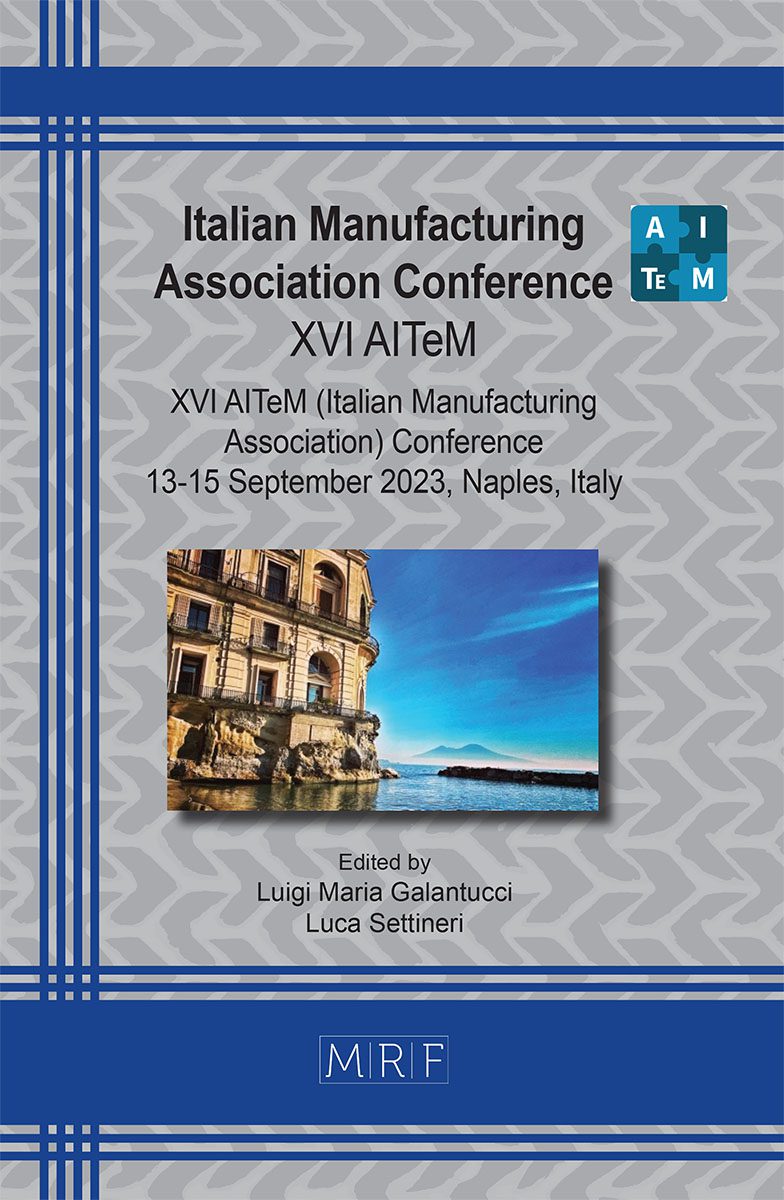Effect of layer and raster orientation on bending properties of 17-4 PH printed via material extrusion additive manufacturing technology
Alessandro Pellegrini, Maria Grazia Guerra, Fulvio Lavecchia, Luigi Maria Galantucci
download PDFAbstract. Material Extrusion (MEX) is one of the most popular Additive Manufacturing technologies. Over the years, the material portfolio has expanded and nowadays, it covers metals such as stainless steels, copper and titanium alloys. The mechanical behaviour of metal parts realized by MEX is of great interest to understand both the potentialities and the limits of the technology. In the present work, a commercial filament of 17-4 PH stainless steel was used as feedstock material to realize four groups of bending specimens obtained by varying the printing direction and the infill line strategy. The main goal of the paper was to evaluate the effect of the above-mentioned factors on the flexural properties. With this purpose, a three-points bending test was performed and results were analysed using the one-way ANOVA approach. The density of the parts was also evaluated.
Keywords
Material Extrusion, Stainless Steel, Debinding and Sintering, Bending Property
Published online 9/5/2023, 8 pages
Copyright © 2023 by the author(s)
Published under license by Materials Research Forum LLC., Millersville PA, USA
Citation: Alessandro Pellegrini, Maria Grazia Guerra, Fulvio Lavecchia, Luigi Maria Galantucci, Effect of layer and raster orientation on bending properties of 17-4 PH printed via material extrusion additive manufacturing technology, Materials Research Proceedings, Vol. 35, pp 135-142, 2023
DOI: https://doi.org/10.21741/9781644902714-17
The article was published as article 17 of the book Italian Manufacturing Association Conference
![]() Content from this work may be used under the terms of the Creative Commons Attribution 3.0 license. Any further distribution of this work must maintain attribution to the author(s) and the title of the work, journal citation and DOI.
Content from this work may be used under the terms of the Creative Commons Attribution 3.0 license. Any further distribution of this work must maintain attribution to the author(s) and the title of the work, journal citation and DOI.
References
[1] P. Parenti, D. Puccio, B.M. Colosimo, Q. Semeraro, A new solution for assessing the printability of 17-4 PH gyroids produced via extrusion-based metal AM, J. Manuf. Process. 74 (2022) 557–572. http://doi.org/10.1016/j.jmapro.2021.12.043
[2] M. Carminati, M. Quarto, G. D’urso, C. Giardini, G. Maccarini, Mechanical Characterization of AISI 316L Samples Printed Using Material Extrusion, Appl. Sci. 12 (2022). http://doi.org/10.3390/app12031433
[3] W. Lengauer, I. Duretek, M. Fürst, V. Schwarz, J. Gonzalez-gutierrez, S. Schuschnigg, C. Kukla, M. Kitzmantel, E. Neubauer, C. Lieberwirth, V. Morrison, Fabrication and properties of extrusion-based 3D-printed hardmetal and cermet components, Int. J. Refract. Metals Hard Mater. 82 (2019) 141–149. http://doi.org/10.1016/j.ijrmhm.2019.04.011
[4] M. Sadaf, M. Bragaglia, F. Nanni, A simple route for additive manufacturing of 316L stainless steel via Fused Filament Fabrication, J. Manuf. Process. 67 (2021) 141–150. http://doi.org/10.1016/j.jmapro.2021.04.055
[5] L.M. Galantucci, A. Pellegrini, M.G. Guerra, F. Lavecchia, 3D printing of parts using Metal Extrusion: an overview of Shaping Debinding and Sintering technology, Adv. Technol. Mater. 47 (2022) 25–32. http://doi.org/10.24867/ATM-2022-1-005
[6] J. Gonzalez-Gutierrez, S. Cano, S. Schuschnigg, C. Kukla, J. Sapkota, C. Holzer, Additive manufacturing of metallic and ceramic components by the material extrusion of highly-filled polymers: A review and future perspectives, Materials (Basel). 11 (2018). http://doi.org/10.3390/ma11050840
[7] F. Lavecchia, A. Pellegrini, L.M. Galantucci, Comparative study on the properties of 17-4 PH stainless steel parts made by metal fused filament fabrication process and atomic diffusion additive manufacturing, Rapid Prototyp. J. 29 (2023) 393–407. http://doi.org/10.1108/RPJ-12-2021-0350
[8] J. Gonzalez-gutierrez, S. Cano, J.V. Ecker, M. Kitzmantel, F. Arbeiter, C. Kukla, C. Holzer, Bending Properties of Lightweight Copper Specimens with Different Infill Patterns Produced by Material Extrusion Additive Manufacturing , Solvent Debinding and Sintering, Appl. Sci. (2021). http://doi.org/10.3390/app11167262
[9] P. Singh, V.K. Balla, S. V. Atre, R.M. German, K.H. Kate, Factors affecting properties of Ti-6Al-4V alloy additive manufactured by metal fused filament fabrication, Powder Technol. 386 (2021) 9–19. http://doi.org/10.1016/j.powtec.2021.03.026
[10] M.Á. Caminero, A. Romero, J.M. Chacón, P.J. Núñez, E. García-Plaza, G.P. Rodríguez, Additive manufacturing of 316L stainless-steel structures using fused filament fabrication technology: mechanical and geometric properties, Rapid Prototyp. J. 27 (2021) 583–591. http://doi.org/10.1108/RPJ-06-2020-0120
[11] G. Singh, J.M. Missiaen, D. Bouvard, J.M. Chaix, Copper additive manufacturing using MIM feedstock: adjustment of printing, debinding, and sintering parameters for processing dense and defectless parts, Int. J. Adv. Manuf. Technol. 115 (2021) 449–462. http://doi.org/10.1007/s00170-021-07188-y
[12] Y. Thompson, J. Gonzalez-Gutierrez, C. Kukla, P. Felfer, Fused filament fabrication, debinding and sintering as a low cost additive manufacturing method of 316L stainless steel, Addit. Manuf. 30 (2019) 100861. doi:10.1016/j.addma.2019.100861.
[13] C. Suwanpreecha, A. Manonukul, On the build orientation effect in as-printed and as-sintered bending properties of 17-4PH alloy fabricated by metal fused filament fabrication, Rapid Prototyp. J. 28 (2022) 1076–1085. http://doi.org/10.1108/RPJ-07-2021-0174
[14] T.C. Henry, M.A. Morales, D.P. Cole, C.M. Shumeyko, J.C. Riddick, Mechanical behavior of 17-4 PH stainless steel processed by atomic diffusion additive manufacturing, Int. J. Adv. Manuf. Technol. 114 (2021) 2103–2114. http://doi.org/10.1007/s00170-021-06785-1































